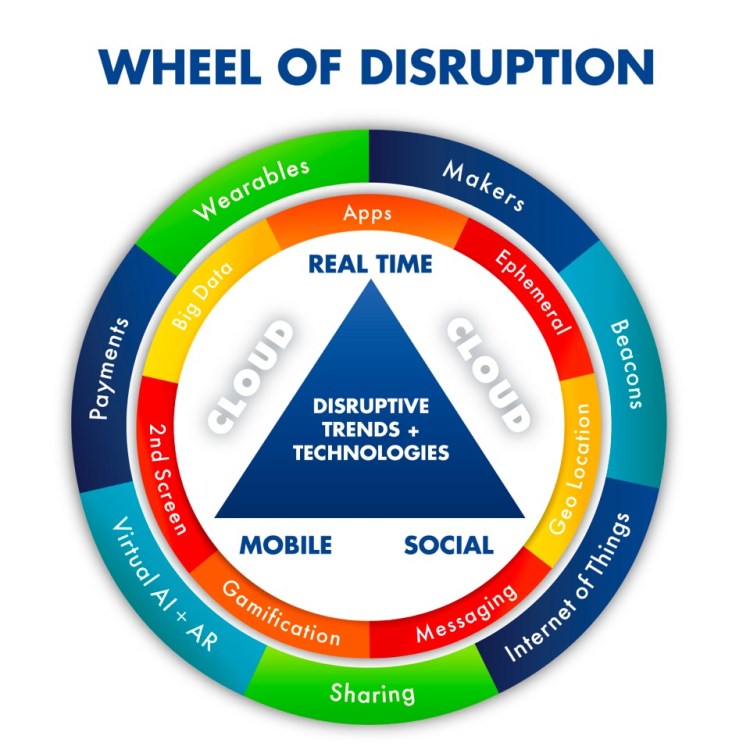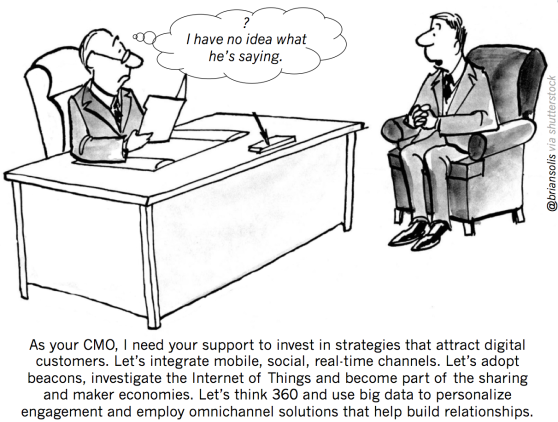Want smarter insights in your inbox? Sign up for our weekly newsletters to get only what matters to enterprise AI, data, and security leaders. Subscribe Now
Social, mobile, real-time, cloud, geo-loco, ephemeral, wearable, AR, makers, sharing economy, beacons, IoT, second screen.
Walk into any coffee shop in San Francisco and you’ll hear one or more of these buzzwords voiced more than you’ll hear “please,” “thank you,” or “you’re welcome.” But that’s what makes the tech sector rich material for shows such as HBO’s new comedy series “Silicon Valley” right?
These terms, however, are more significant than they are trendy in that they’re affecting society in ways that many don’t yet realize. To use another buzzword, these technologies are in fact disrupting markets as they influence changes in everyday behavior and expectations.
As a result, technology’s affect on society is slowly but surely disrupting business models that cannot keep up with more connected, nimble, and informed customers. I refer to this evolution as “digital Darwinism.”
We know technology and society are developing. The question is whether or not businesses of today choose to adapt or merely die a slow death by a thousand digital cuts.
Currently, several disruptive technologies are converging to form what venture capitalist Fred Wilson calls a Golden Triangle of Disruption. It’s defined by 1) real-time, 2) social media, and 3) mobile technology trends. The result of this intersection is completely altering how people connect, communicate, and discover information. This affects influence and decision-making, which, in turn, affects the entire customer journey and ultimately the customer lifecycle. To what extent, I wondered….
To answer that question, between 2013 and 2014, I interviewed over 20 leading strategists at some of the world’s most celebrated businesses to understand why and how companies are changing. What I found was so much more than technology-influenced strategies to bring about change. For starters, I learned that empathetic businesses, in their own way, were using technology as a way of better understanding the people formerly known as consumers.
Not only are companies adapting, many are pursuing a formal effort of “digital transformation.” Beyond new technology investments, digital transformation affects traditional business models and current technology roadmaps to get ahead of rather than merely react to connected customers and employees. My work over the last year culminated in a new Altimeter Group report, “Digital Transformation: Why and How Companies are Investing in New Business Models to Lead Digital Customer Experiences” and it is available today as a free download.
Digital transformation is a result of businesses seeking to adapt to this onslaught of disruptive technologies affecting customer and employee behavior. As technology becomes a permanent fixture in everyday life, organizations are faced with an increasing need to update legacy technology strategies and supporting methodologies to better reflect how the real world is evolving.
From social and mobile, to customer insights and journey mapping, to IT and training, digital transformation improves how businesses see their customers and create value throughout their lifecycle. This led to a purpose-driveN definition of digital transformation, in the context of this research, as the “re-alignment of, or new investment in, technology and business models to more effectively engage digital consumers at every touchpoint in the customer experience lifecycle.”
What’s driving change?
Executives leading digital transformation were motivated by the substantial differences between connected and traditional customers. The way today’s consumers use screens and what they expect to accomplish does not mirror traditional customers of the past. Their values are shifting. And, how they make decisions no longer aligns with a traditional funnel model. Expectations are reshaping engagement and, ultimately, the way their relationships with companies unfold.
One interesting point that surfaced again and again in this research is that digital transformation isn’t an end goal; it’s a continuous journey. It’s the result of learning more about the relationship between technology and customer behavior to earn relevance among them.
Change is constant for the foreseeable future, as the companies we interviewed are seeking answers to questions about digital customers and how they differ from current customers:
- What uniquely defines the persona of our customers?
- What is different about their customer journey?
- What are the touchpoints they frequent, how do they use them, and with what devices?
- What are their expectations, what do they value, and how do they define success?
- How are they influenced, and by whom? How and whom do they in turn influence?
Businesses are now faced with connecting the dots to understand behavior, map customer journeys, and redefine them to create experiences that are not only delightful, but also seamless and native to the screen and the context of the engagement.
This sparks the need for digital transformation that uses technology to connect with consumers and equally amends or introduces new processes and systems to successfully compete.
For example, Intuit shared in our discussions that it studies the relationship between customer technology usage and path to purchase.
The Intuit team starts with a simple but integral question, “Based on technology adoption, what is our customer’s path to purchase?” The team looks beyond demographics and invests in psychographics (i.e., shared behaviors and interests) to create accurate buyer personas and better understand the new customer journey.
The result is to deliver a more natural and meaningful experience.
It’s so much more than tech or trends … it’s also about creating a culture of adaptation and innovation.
Although technology isn’t the only catalyst for digital transformation, companies see new tech adoption as a form of progress to deliver better customer experiences. As such, technology investments are expressions of experimentation.
Nestlé’s Global Head of Digital and Social, Pete Blackshaw, embraces innovation and experimenting along the way to ultimate transformation. Although Blackshaw believes Nestlé is still in the process of becoming “transformed,” the company is setting out to answer difficult questions to understand and optimize the customer experience. It’s a journey that has introduced new challenges, urged departmental and process reorganization, and inspired a company culture of innovation. This is done to leverage diverse market potential and create exponential value.
To lead transformation, Nestlé formed an innovation acceleration team and opened an innovation outpost in Silicon Valley, California, to “deepen relationships with consumers online and in social media.” The company is seeking strategic partnerships with innovative companies to better understand consumers’ needs and respond to them more quickly.
This is just the beginning. Digital transformation represents a journey for businesses who seek to compete for attention and affinity of a different type of customer, a customer who requires a different set of human-centered paths, touch points, and outcomes.
Technology is just one part of the equation. While I set out to learn how digital technologies are impacting customer behavior and how businesses are responding to these changes, I heard over and over again about the importance of the human side of change. Customers are changing, yes. But so are employees. And behind most of the change is the story of people inside organizations who are making the case to do things differently, the challenges they face, and the benefits they’re starting to realize.
In the case of digital transformation, at least among those brands that I had the chance to work with, this isn’t just business, it’s now personal.
Brian Solis is a digital analyst, business strategist, and futurist who creates new media strategies and frameworks that build bridges between companies and customers, and with employees and key stakeholders. As a Principal Analyst at Altimeter Group, he specializes in change management that empowers business leaders to introduce new media resources, systems and processes, as well as to deliver the infrastructure that enables organizations to “embrace and excel” in today’s era of the connected customer.



